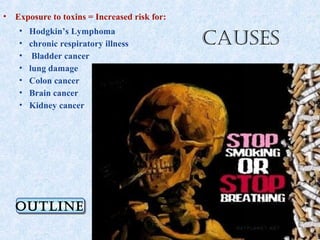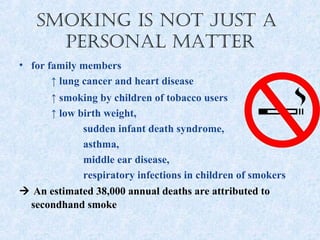Health
- 1. Luci A #1 9-2 9.11
- 2. Outline Click 1) What is the health problem or risk? 1) What is the health problem or risk? 2) What are its causes? 2) What are its causes? 3) Who is at risk? 3) Who is at risk? 4) How can it be prevented? 4) How can it be prevented? 5) Is there a cure? 5) Is there a cure?
- 3. health prOblem… Smoking is a huge drain on USA’s health, health care costs, and productivity • Lung Cancer • Cigarette smoke damages cells. This cell damage can lead to tumors that often start in the lungs. Lung cancer can spread to other parts of the body… • …Once lung cancer occurs, the cancer cells can break away from the lungs and spread to other parts of the body.
- 4. health risks • Chronic obstructive pulmonary disease, or C-O-P-D, refers to a group of lung conditions including emphysema and chronic bronchitis, which make it hard to breathe. These conditions can get progressively worse, as further smoking- related lung damage occurs. The number of people in the U-S with C-O-P-D is approximately twenty- four million
- 5. Smoking makes it easier for clots to form that can block the flow of blood. A stroke happens when blood can’t get to the brain. Cigarette smoke damages the walls of the blood vessel, and also makes it easier for clots to form, which increases the risk for a stroke.
- 6. risk? • The Death • Smoking kills more people than alcohol, AIDS, car accidents, illegal drugs, murders, and suicides combined • Fires caused by smoking annually around the world • Smoking adds to the damage from hepatitis Outline Outline
- 7. • Exposure to toxins = Increased risk for: Hodgkin’s Lymphoma causes • • chronic respiratory illness • Bladder cancer • lung damage • Colon cancer • Brain cancer • Kidney cancer Outline Outline
- 8. WhO is at risk? • Society’s Problem • People who die each year from their own cigarette smoking: approximately 438,000 • People who die each year from others’ smoking: approximately 38,000
- 9. Smoking iS not JuSt a PerSonal matter • for family members ↑ lung cancer and heart disease ↑ smoking by children of tobacco users ↑ low birth weight, sudden infant death syndrome, asthma, middle ear disease, respiratory infections in children of smokers An estimated 38,000 annual deaths are attributed to secondhand smoke
- 10. How can it be Prevented? Smoking is the number one preventable cause of premature death in the United States! • Parents can set a positive example for their children by not smoking themselves, and keeping their homes smoke-free. • Schools can provide tobacco prevention programs to educate students about the dangers of smoking. • States can pass legislation to increase taxes on tobacco products, pass and implement comprehensive smoke free indoor air laws, and limit minors' access to tobacco products. • youth smoking can be prevented with the combined efforts of families, schools, communities and policy makers. outline outline • Staying Smoke-Free • AWARENESS • PREPARATION
- 11. Preparing to Quit iS tHere a cure? Make a personal commitment Quitting smoking may be the most important step that you can take to improve your health. • prepare your mind and body to quit best chance of quitting if you. • Think about why you want to quit • Find out how your doctor can help you overcome nicotine cravings when you quit smoking • Figure out what changes you can make in your own habits to help you avoid smoking
- 14. bibliography • Stop Smoking Benefits Timetable." Stop Smoking Benefits Timetable. N.p., n.d. Web. 13 Nov. 2012. <http://www.whyquit.com/whyquit/A_Benefits_Time_table.ht ml>. • "Welcome to IAFFonline!" Welcome to IAFFonline! N.p., n.d. Web. 13 Nov. 2012. <http://www.iaff.org/smokefree>. • "Preventing Smoking." Freedom From Smoking® Online. American Lung Association, n.d. Web. <http://www.lung.org/stop-smoking/about- smoking/preventing-smoking/>.













